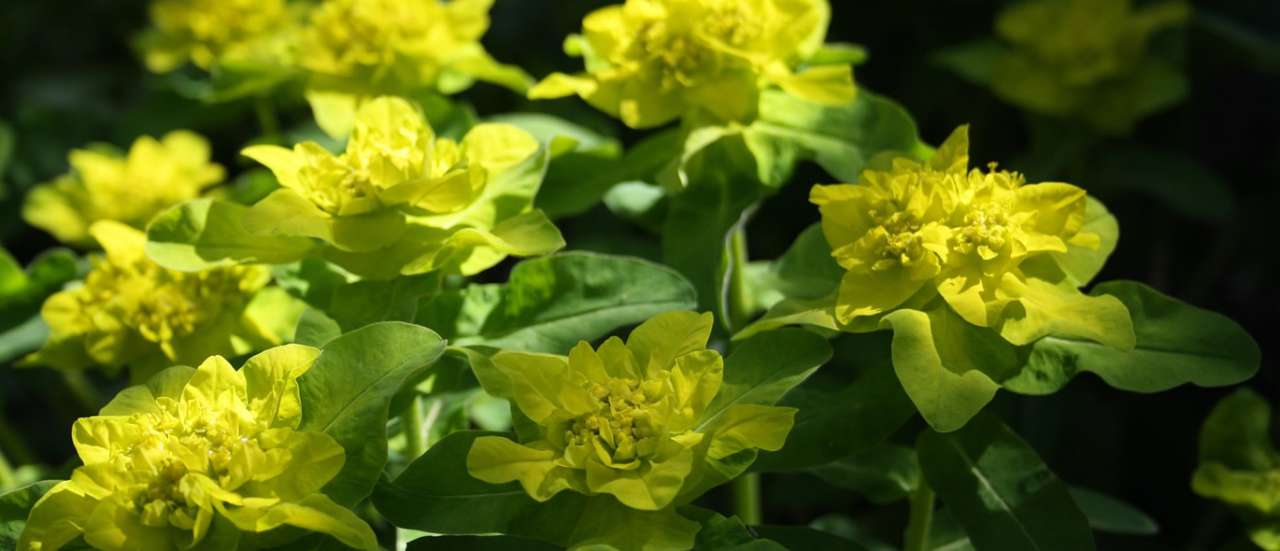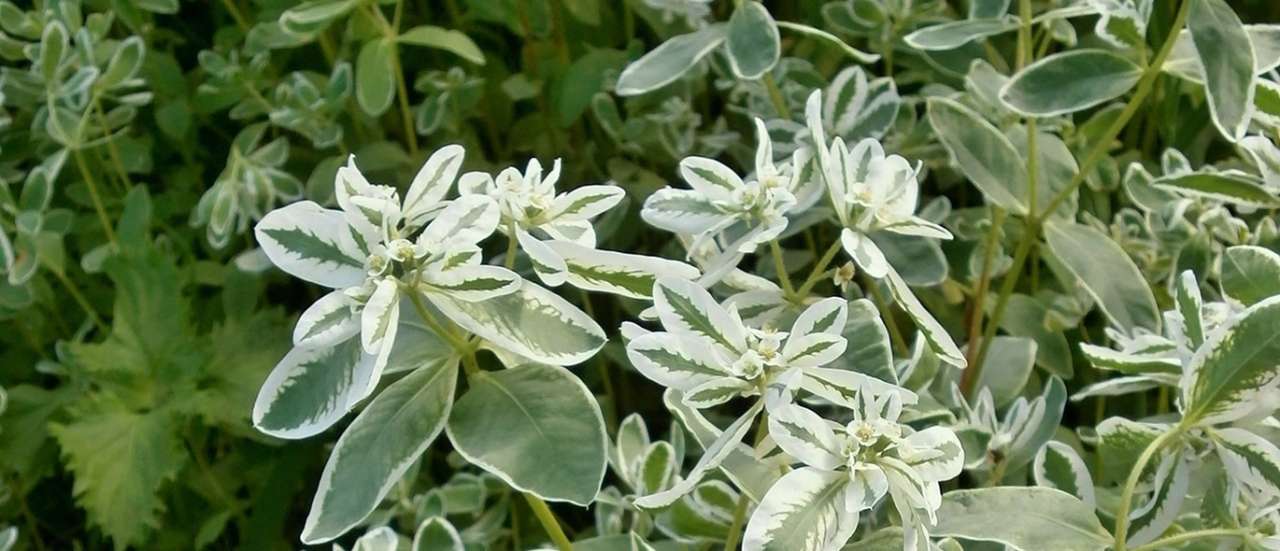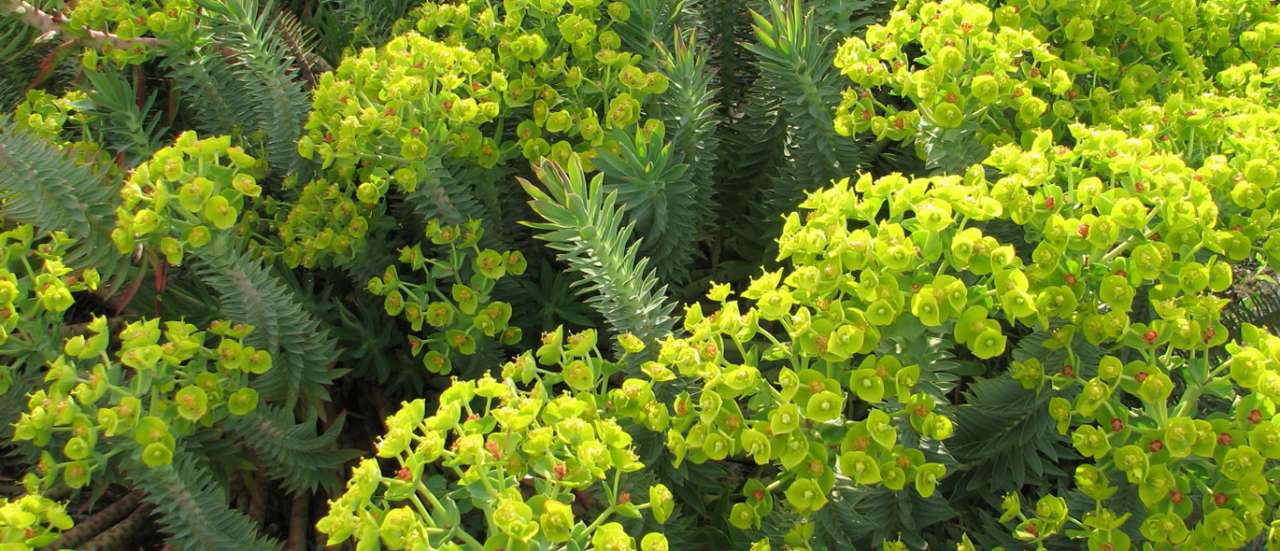Euphorbia is a large and varied genus of plants that includes houseplants that look like cacti, garden perennials and even the popular Christmas Poinsettia. In this quick guide we will be taking a look at those shrubby garden perennials that have become a popular garden staple and, for the most part, provide a range of foliage colours and textures throughout the year - not to mention those unusual flowers that are generally produced in spring and summer. The flowers come in eye-catching colours of acid yellow, orange or red with foliage colours that range from bright green, through silvery-blue and purple and some providing rich red autumn colours later in the year.
In terms of size there are varieties that range from 10cm in height to 6ft (180cm) and as well as looking great in their own right, they are a wonderful plant for mixing with other shrubs and perennials to either provide a backdrop to your more showy flowers, or for adding texture and colour to your borders that will remain consistent throughout the year, given the right conditions.
 Euphorbia - Image by Rob Leake from Pixabay
Euphorbia - Image by Rob Leake from Pixabay
Where and How to grow:
Garden varieties of euphorbia or 'Spurge' as they are often known, are considered to be woodland plants and so most will require a fairly fertile, moist but free-draining soil in a sheltered position that offers full sun or partial shade. As with any genus of plants it is always worth checking the specifications and description as some euphorbias are more hardy than others and there are those that will be better at tolerating wet or dry conditions. Those that are more tolerant of shade can be used to underplant larger shrubs or trees and can offer a degree of weed suppression. Other than that it will be the size and foliage colour that will determine your choice as you may want something to provide a backdrop of year-round greenery and softness to your borders or be looking for a plant to provide contrasting accents amongst your shrubs and flowering perennials.
Euphorbias are best planted in spring as the soil starts to warm up as this provides the ideal conditions for plants to establish quickly. This is particularly true of the silver and blue leaved varieties such as 'Silver Swan' as they tend to struggle with becoming established in the wetter, colder soils of autumn and winter. If you are planting other varieties through the summer, you may need to insure they are watered during any dry periods, although, in Ireland at the moment, most summers will provide adequate rainfall and warmth to imitate spring conditions anyway - especially in the west.
If your looking for a container plant, then you're probably out of luck with most euphorbias as they really do prefer to be planted in the soil where, if planted in the correct conditions, once established they can be left to grow with little aftercare. Those varieties that are listed as requiring free-draining soils however, which you will tend to find in the 'alpines' section, like euphorbia myrsinites, will take well to container growing in a mix of something like three parts John Innes No.3 and one part grit.
In terms of the actual planting, euphorbias are just like most other perennials with just a couple of extra tips to take into consideration.
- Dig a hole as deep as the pot they are in and a little wider. For those euphorbias that are listed as requiring more 'moist but well-drained' conditions it is advisable to backfill with some organic matter such as compost or well-rotted manure.
- For varieties that demand a more free-draining, sandy soil, the addition of organic material will be unnecessary. This is because you may then encourage the soil to retain too much moisture for the free-draining soil lover (like euphorbia myrsinites). For such varieties this may also add too many nutrients, causing them to grow weak and leggy (which can also make them more susceptible to pest and climate damage - frost, wet etc.).
- Once planted, firm in and water well ensuring that the soil stays fairly moist until you can see that the plant is fully established and providing new growth.
Euphorbia care:
Euphorbia are very low maintenance and once established they do not require any ongoing feeding or special care. If you are growing a suitable variety in a container though, you will need to make sure the soil doesn't completely dry out from spring to autumn, holding off on the watering during the winter season to prevent rot or frost damage over the colder season
With almost all varieties it is worth cutting back the flowering stems once they have finished flowering.
Important Note: With all Euphorbia you should wear protective gloves when handling the plant as the sap in these plants is a skin and eye irritant and is poisonous if digested. This is definitely something to take into consideration when purchasing, especially if you have young children who are active in the garden. These can also cause problems for pets if they are exposed to the sap, although in general, this is unlikely but still worth considering
Most perennials will benefit from a mulch once per year to keep weeds down and prevent too much evaporation, this is also true of euphorbias BUT if you have those free-draining-soil loving varieties or those with silvery or blue leaves, this is best done with shale, grit or stone of some kind, as, again, they will not tolerate too much moisture or high nutrient levels.
Propagation:
There are really two methods for propagating euphorbias depending on the variety you have chosen:
Herbaceous clump-forming varieties are best propagated by division. For spring flowering varieties this is best done just after they finish flowering and for summer flowering varieties this is best left until the following spring as the new growth starts to emerge. Gently lift the whole plant with a fork and divide into sections that have a good number of roots to each for re-planting. This is best left until the plants have been in the ground for 3 years and are fully established.
For the more 'shrubby' perennials that generally produce stems one year that flower in the next year 'softwood' cuttings can be taken in late spring. Again, you must wear protective gloves when doing this to prevent any adverse reaction from the sap, which will definitely ooze from the stems that you cut. Cut a short section of a non flowering stem, about 20-30 cm long and, if you are doing several cuttings, place them in a plastic bag so as to retain moisture until you come to potting them up. Trim each stem, just leaving 2-4 leaves at the top and make a clean cut under a leaf node at the bottom of the cutting. You can (although not essential) dip the bottom of the cutting in charcoal powder to seal the sappy cut.
Take a 9cm pot (or larger if you want to add more cuttings) filled with freely draining compost and add 3 or 4 cuttings at the edges of the pot, planting them so about 2/3 of the cutting is below the soil. Then it's just a case of keeping them in a shaded area and ensuring the soil is kept moist until roots begin to emerge from the bottom of the pot. Once they do these can be potted on and grown to a point where you are satisfied they can go into the garden.
 Euphorbia - Image by RococoNeko from Pixabay
Euphorbia - Image by RococoNeko from Pixabay
Euphorbia Companions
Euphorbias are very versatile plants to match up with pretty much anything that will grow in similar moist but free-draining to free-draining conditions in full sun or partial shade. Here are a few of our favourite combinations:
- Plant spring to summer, yellow flowering varieties amongst purple flowering varieties of allium, that will really make those global clusters of purple pop in the garden.
- The silver/blue leaved varieties like Silver Swan that like more Mediterranean conditions are perfect for planting with other Mediterranean plants like Eryngium, Lavender, Rosemary and Thyme. The combination will provide a variety of colours, textures and fragrances that will be a feast for the senses throughout the year
- Plant more compact, shorter growing varieties of euphorbia amongst other alpine plants such as ajuga, saxifrage, dianthus and even sedums to create a beautiful textured tapestry within a rock garden
Euphorbia are just another one of those plants that provide for a variety of uses given the right drainage and light conditions, and will provide interest to your garden throughout the year with very little maintenance required. Our online selection varies throughout the year or you can call into one of our stores in Boyle or Roscommon Town where our experienced staff will be on hand to provide any further advice you may need.
 Euphorbia Rigida - Seán A. O'Hara (CC BY-SA 2.0)
Euphorbia Rigida - Seán A. O'Hara (CC BY-SA 2.0)




